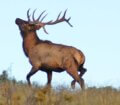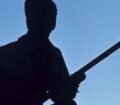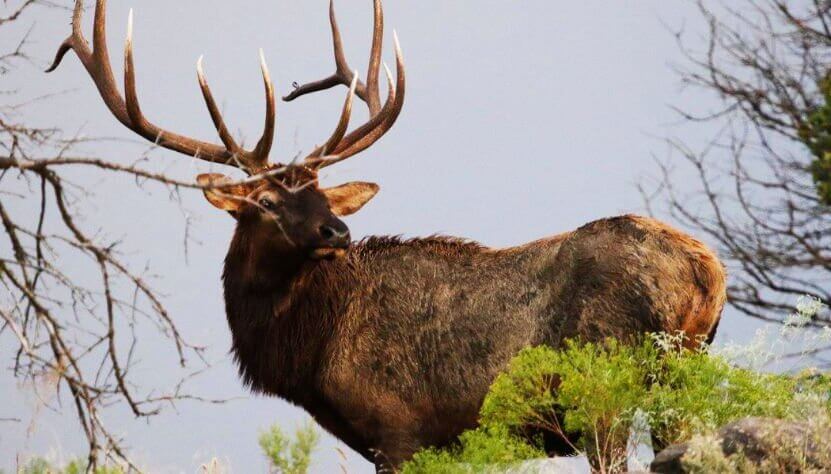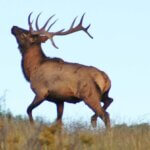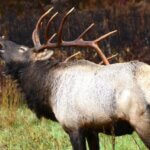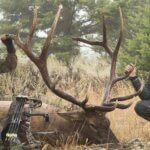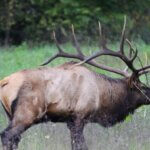Editor’s Note: Will Primos of Flora, Mississippi, has been hunting elk every year since 1988. “I’ve had some fantastic opportunities in my lifetime to call in hundreds of bull elk,” he explains. Primos, the creator of Primos Hunting (https://www.primos.com/) and generally hunts for elk in three states annually. He’s been producing videos and products for the elk-hunting industry for many years. “We wanted to get the public excited about not just elk but hunting and protecting them as well,” Primos says. “We’re strong supporters of the Rocky Mountain Elk Foundation and its mission.” Primos doesn’t just call and take elk himself, he also guides and calls for other people. Primos has taken or called more than 200+ elk for others for his videos.
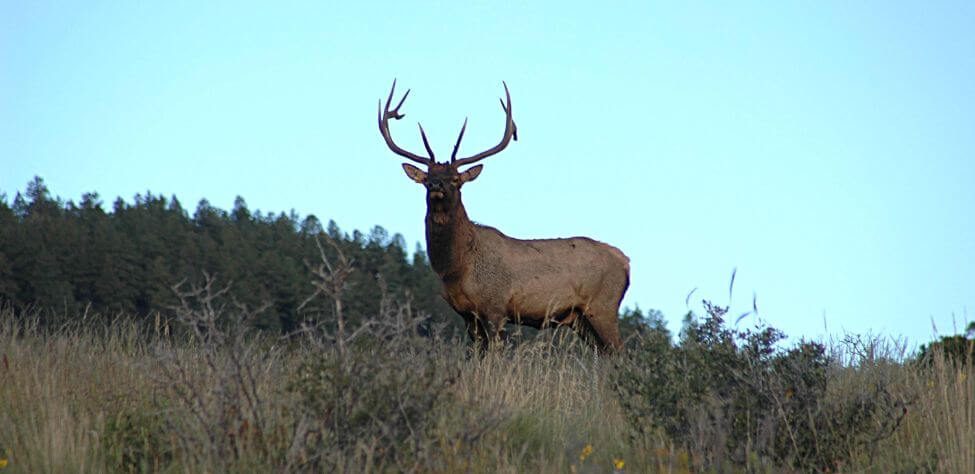
We hunted in 2000 in Montana. Some wildfires had broken out in the Belt Mountains, and we were hunting on a ranch not far from the Missouri River near Three Forks, Montana. A good portion of the ranch had been burned. This hunt took place early in the season when a snowstorm had moved through, so there was about 2 feet of snow on the ground. We’d gone up the mountain for several days and never found a bull or any sign of elk. From what we observed, we were pretty sure that the fire had pushed most of the elk, if not all of the elk, off the mountain.
On the way back to camp, I was driving and spotted a bull. The windshield wipers were on intermittent – not because the snow was still falling – but due to the wind blowing some of the snow off the branches and trees. A “cashoo” sound emitted from the wipers as they went back and forth across the front window. The bull picked his head up but couldn’t see us because I’d stopped the vehicle. “Big bull, big bull…and I think he’s out there by himself,” I told everyone. The bull was only about 75-yards away from us, until he finally turned away from us and walked down into a canyon. We all jumped out of the truck when we knew the bull couldn’t see us and tried to close in the distance between us and the bull. Soon enough, the bull came out of the canyon and went up the same mountain where we were. I cow called, and he hadn’t gone far before he stopped and bugled.
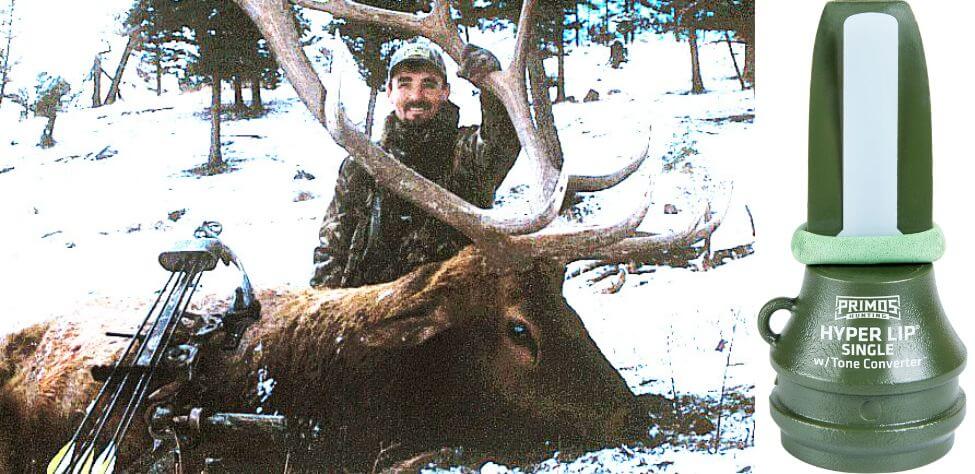
I was running the video camera and calling. Brad Farris, a friend of mine who drew a tag on this land, was to be the shooter. Once we got set-up, the bull came by us at about 40 yards. Brad was ready to shoot. As I was cow-calling the elk, Brad had the perfect shooting lane to take a shot. However, as the bull started walking toward us, Brad didn’t call to stop the elk. He’d forgotten to put a cow call in his mouth. Since I had one, I mewed, and the bull stopped right in the middle of Brad’s shooting lane. He already had ranged the distance to where the bull was stopped, so he released the arrow and made a perfect shot. This was a tremendous-sized bull, scoring about 397 inches – an absolute monster.
Finding a bull, calling him in to an archer, and the archer making a good shot are the easiest parts of an elk hunt. The real work begins when the bull’s on the ground. Fortunately, while hunting in the Gila Wilderness of New Mexico one time, a guide there had taught us how to get the meat off the elk without having to gut him by skinning him down the back, getting the tenderloins out and taking the rest of the meat off the elk without field dressing it first. Since there were four of us, we were able to drag that bull down the mountain and get him to a road. We then used our pickup truck to load-up the elk and take him back to camp. Getting an elk out of the mountains or steep terrain is often an all-night or most-of-the-day type of job. On each elk hunt, I build some great memories with friends, while getting videos to remember them.
Tomorrow: Taking a Muzzleloader Elk on Louisiana Purchase Land
Looking for more content? Check out our YouTube channel and watch How to Make Tartar Sauce by John E. Phillips.
Expert Guidebooks on Elk Hunting: Best Sellers

Secrets for Hunting Elk
The quickest, easiest (if there is an easy way), and safest way to find and take that bull elk of a lifetime will be to hunt with a guide.
Chad Schearer, a longtime Montana guide and TV personality, told me, “My hunter is my gun. If I get to the elk, and my hunter isn’t with me, then we don’t take the elk. My job is not only to find the elk but also to help the hunter get to the elk and make the experience as enjoyable as I can for him.” That’s the kind of fella with whom I want to go elk hunting.
An elk hunt can be tough, but it doesn’t have to be so tough that you don’t enjoy it. That’s why this elk hunting book starts with the confessions of an elk guide and with Chad Schearer’s philosophy of what the guide and the hunter’s relationship should be.
A good portion of your success will depend on your physical condition, and Matt Morrett of Harrisburg, Pennsylvania explains how an eastern hunter can get ready physically during June and July to hunt western elk, the animals he describes as, “Like deer or turkeys on steroids.”
Wayne Carlton, well-known elk hunter and TV and video personality from Montrose, Colorado, tells us what types of elk calls to use and what to say to the elk. Mike Miller of Colorado, another elk guide and Mossy Oak video personality, has tactics for the best equipment for bowhunting and gun hunting elk.
You’ll learn helpful strategies and hunting tips in this book, as well as some straightforward hunting methods that will help to make your elk hunt more successful.
“Thanks to the advice in your elk hunting books, I was able to call up a nice 6-point (6X6) bull elk! He was bugling like crazy. I called him in from about a ¼ mile away. Called him into bow range (about 40 yards away). It was a thrill!” ~Rob Brannon
VERSIONS: AUDIBLE & KINDLE

Elk: Keys to 25 Hunters’ Success
Often just one tip or tactic makes the difference in whether you take an elk home to dinner or have to hike back to the truck by yourself. In John E. Phillips’ latest elk book, Elk: Keys to 25 Hunters’ Success, you’ll learn from successful elk hunters the strategies they use to find and take elk.
Many know that the technique that seems to work most often is to hunt where other elk hunters don’t and understand where the elk are before you go on a hunt by studying data from each state, visiting HuntData (see chapter 1), examining maps, and reading postings on elk forums.
This book also tells you how to get ready physically for an elk hunt, including participating in Train to Hunt Competitions, what gear you need to take, how to enjoy a successful do-it-yourself elk hunt, or how to pick the best elk guide for you. You’ll also hear about the X System and the Broken Y System of hunting elk.
Although no one person has all the answers on how to help you find and take your elk, I’m convinced that this book’s outdoors men and women will teach you how to have satisfying elk hunts.
As my friend Karl Badger once told me, “Elk hunting doesn’t get any better than when I ride horses into the high backcountry, see two grizzly bears, hear a pack of wolves howl close to camp all night long, eat plenty of delicious food prepared on a fire and enjoy the company of good friends.”
VERSIONS: AUDIBLE, KINDLE & PRINT

How to Find Your Elk and Get Him in Close will teach you the tactics of 10 nationally known elk hunters, to help put that giant bull that’s been screaming at you from afar, in your lap. You’ll learn what some of the best guides, outfitters, and successful elk hunters do to find elk and get them in really close.
Also in this audiobook, you’ll notice that the majority of the experts call elk to within bow range. We selected numerous bowhunters and bowhunting guides, since the bowhunter has to get much closer to a bull than the gun hunter does – often less than 20 or 30 yards – practically in your lap.
On one elk hunt, I’d heard this bull bugle all morning. My guide had called him within 30 yards, and he was standing just inside black timber. I saw the smoke from his nose wafting out into the icy air less than 30-yards away. All the bull had to do was step out, and I could take the shot with my bow. But then, through no fault of my guide or me, the bull vanished.
The only conclusion I could come up with to understand why the bull I wanted to take with my bow hadn’t stepped out and given me a shot, was because he got raptured. He evidently had left the earth with no trace of himself.
This hunt was when I started wanting to learn more about hunting elk up close. In this book, I’ve tried to find some of the most knowledgeable, experienced, and practical elk hunters. I’ve always found that the best way to learn any outdoor skill, is to either hunt or fish with the best sportsmen in that field.
Often, in elk hunting, that means elk guides, who generally hunt every day of the season and receive a salary for every hunter they guide. So, I’ve put together a group of some of the best elk hunters I know to help us all learn how to find bull elk and get them in close.
VERSIONS: AUDIBLE, KINDLE & PRINT

